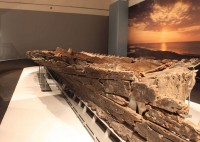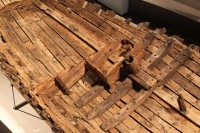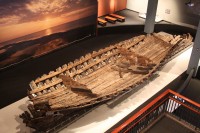 After 17 years, restoration of the hull of La Belle, one of four ships that carried French explorer René-Robert de La Salle and 300 would-be colonists on his mission to the Gulf of Mexico, is finally complete.
After 17 years, restoration of the hull of La Belle, one of four ships that carried French explorer René-Robert de La Salle and 300 would-be colonists on his mission to the Gulf of Mexico, is finally complete.
La Belle was a 54-foot frigate that could navigate open ocean but was had a shallow enough draft that it could hand coastal and river waters as well, an essential design for this trip since La Salle’s aim was to found a colony in the Mississippi River Delta. Their poor maps of the Gulf sent the explorers way off course. When his main storeship, L’Aimable, ran aground, La Salle was compelled to transfer as much of her contents as he could salvage to La Belle, so when a storm claimed her too off the coast in Matagorda Bay, 400 miles west of the Mississippi Delta, in 1686, she sank with a disproportionately huge complement of artifacts and supplies.
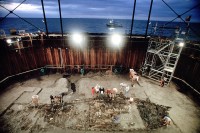 That gave the Texas Historical Commission archaeologists who discovered the wreck in 1995 a lot of work to do. They built a double-walled cofferdam around the wreck, pumped out the water and from September of 1996 to April of 1997, excavated the surviving bottom third of the ship’s oak hull. By the end of the excavation they had recovered nearly 1.6 million objects — barrels of gunpowder, weaponry, personal items, cookware, crates full of trade geegaws (brass rings, pins, hundreds of thousands of glass beads).
That gave the Texas Historical Commission archaeologists who discovered the wreck in 1995 a lot of work to do. They built a double-walled cofferdam around the wreck, pumped out the water and from September of 1996 to April of 1997, excavated the surviving bottom third of the ship’s oak hull. By the end of the excavation they had recovered nearly 1.6 million objects — barrels of gunpowder, weaponry, personal items, cookware, crates full of trade geegaws (brass rings, pins, hundreds of thousands of glass beads).
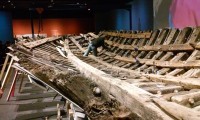 The hull was sent to Texas A&M University’s Nautical Archaeology Program where the timbers were soaked in a bath of polyethylene glycol (PEG) solution, a petroleum-based polymer that replaces the water in wood to keep it from warping, cracking or shrinking when it dries, for 10 years. When the high price of oil made the use of PEG prohibitively expensive, conservators put the timbers in the largest archaeological freeze-dryer in the world. After four years in the freezer, in the summer of 2014 La Belle‘s timbers were transported to the o the Bullock Texas State History Museum in Austin. There they were reassembled in a side gallery where the process could be viewed by the public.
The hull was sent to Texas A&M University’s Nautical Archaeology Program where the timbers were soaked in a bath of polyethylene glycol (PEG) solution, a petroleum-based polymer that replaces the water in wood to keep it from warping, cracking or shrinking when it dries, for 10 years. When the high price of oil made the use of PEG prohibitively expensive, conservators put the timbers in the largest archaeological freeze-dryer in the world. After four years in the freezer, in the summer of 2014 La Belle‘s timbers were transported to the o the Bullock Texas State History Museum in Austin. There they were reassembled in a side gallery where the process could be viewed by the public.
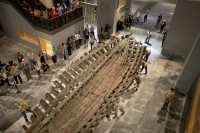 In May of 2015, reassembling of the timbers was complete and the entire hull was moved to the main gallery of the museum, its final resting place after 20 years of upheaval. While the hull timbers were back together again, the restoration wasn’t finished yet. The were gaps that needed to be closed and additional surviving sections of the hull added to the structure. While conservators were working on that, the main gallery was refurbished around the ship’s hull to create the permanent exhibition that would fully showcase La Belle and its many artifacts.
In May of 2015, reassembling of the timbers was complete and the entire hull was moved to the main gallery of the museum, its final resting place after 20 years of upheaval. While the hull timbers were back together again, the restoration wasn’t finished yet. The were gaps that needed to be closed and additional surviving sections of the hull added to the structure. While conservators were working on that, the main gallery was refurbished around the ship’s hull to create the permanent exhibition that would fully showcase La Belle and its many artifacts.
The restoration is now complete and the ship positioned at a 21-degree angle, just as it was on the sea floor when archaeologists excavated it. The temporary exhibition La Belle: The Ship That Changed History, is ongoing now. The permanent exhibition is scheduled to open in November, after which some of the artifacts from the wreck will become part of a traveling exhibition that will visit several locations in the United States and France, which is still the legal owner of La Belle and everything on it.
